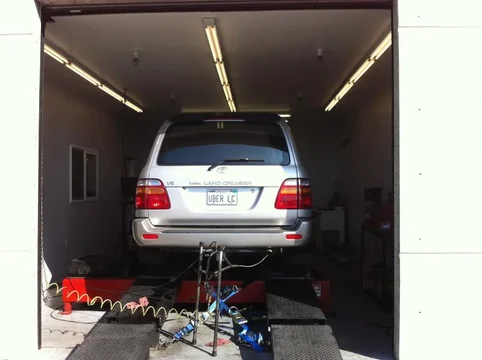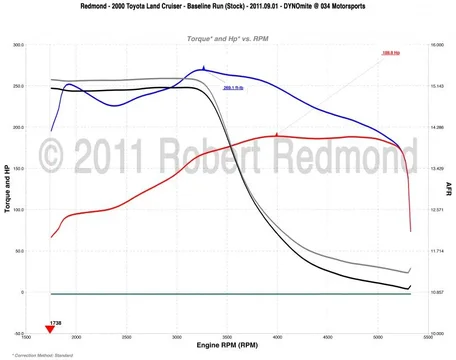DT Headers Dyno Result Thread (Numbers are in)
This is the baseline dyno run for the DT headers Install. We are scheduled to make the followup run 9/8. Headers will be installed 9/2 and I will attempt to put some break in mileage on them before the second run.
The Mileage figures represent when the last service was done. Items listed are for contextual purposes to better understand the state of tune this truck is in and how that could effect readings. Please keep in mind that every single dynamometer will give different numbers. These numbers may appear high or low depending on your side of the fence. That isn’t important. The value of these results and comparisons should provide information on the relative difference adding the DT headers to a stock truck can make.
Vehicle: 2000 Toyota Land Cruiser
Mileage: 146,019
Configuration: All Stock
Variables:
Spark Plugs: OEM @ 139,003 miles
Airfilter: OEM @ 139,003 miles
O2 Sensors: Original @ 0 miles
Fuel: Chevron (CALIFORNIA) 91oct
Engine Oil: Mobil 1 5/30 @ 143,752 miles
Diff / XFer Oil: Mobil 1 75-90 @ 143,804 miles
Driveline Lube: Sta-Lube Extreme Pressure Moly @ 143,804 miles
Throttle Body: Cleaned @ 143,804 miles
Tires: Kelly Safari Trex 5/32 tread/OEM Diameter/36PSI cold pressure
Environment:
Land & Sea Pro 1000 All Wheel Drive Chassis Dyno
Altitude: 40’ above sea level
Air Temp in Bay: 77*
Ambient Air Temp: 68*
Intake Air Temp: 105*
AT temp: 135*
Coolant Temp: 193*
Gear Selection: 2nd Gear Used (power ECT was off)
Results:
Wheel Horsepower: 188.8 @ 4000 RPM
Wheel Torque: 269.1 @ 3250 RPM
* Averaged or merged over 4 back to back runs. Each run had a 2 minute interval between them.

Actual Dyno Charts Will follow below so you can see the AFR and power curves. Torque is flat to peak and horsepower builds in a linear fashion to peak.
---

This is the baseline dyno run for the DT headers Install. We are scheduled to make the followup run 9/8. Headers will be installed 9/2 and I will attempt to put some break in mileage on them before the second run.
The Mileage figures represent when the last service was done. Items listed are for contextual purposes to better understand the state of tune this truck is in and how that could effect readings. Please keep in mind that every single dynamometer will give different numbers. These numbers may appear high or low depending on your side of the fence. That isn’t important. The value of these results and comparisons should provide information on the relative difference adding the DT headers to a stock truck can make.
Vehicle: 2000 Toyota Land Cruiser
Mileage: 146,019
Configuration: All Stock
Variables:
Spark Plugs: OEM @ 139,003 miles
Airfilter: OEM @ 139,003 miles
O2 Sensors: Original @ 0 miles
Fuel: Chevron (CALIFORNIA) 91oct
Engine Oil: Mobil 1 5/30 @ 143,752 miles
Diff / XFer Oil: Mobil 1 75-90 @ 143,804 miles
Driveline Lube: Sta-Lube Extreme Pressure Moly @ 143,804 miles
Throttle Body: Cleaned @ 143,804 miles
Tires: Kelly Safari Trex 5/32 tread/OEM Diameter/36PSI cold pressure
Environment:
Land & Sea Pro 1000 All Wheel Drive Chassis Dyno
Altitude: 40’ above sea level
Air Temp in Bay: 77*
Ambient Air Temp: 68*
Intake Air Temp: 105*
AT temp: 135*
Coolant Temp: 193*
Gear Selection: 2nd Gear Used (power ECT was off)
Results:
Wheel Horsepower: 188.8 @ 4000 RPM
Wheel Torque: 269.1 @ 3250 RPM
* Averaged or merged over 4 back to back runs. Each run had a 2 minute interval between them.

Actual Dyno Charts Will follow below so you can see the AFR and power curves. Torque is flat to peak and horsepower builds in a linear fashion to peak.
---
Last edited:






